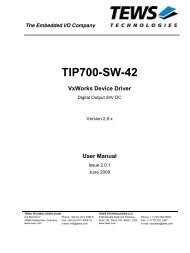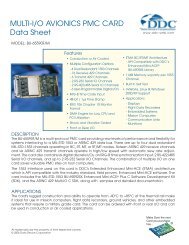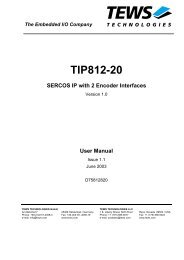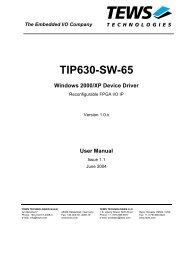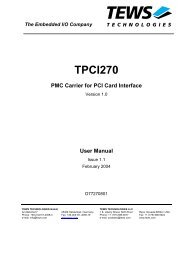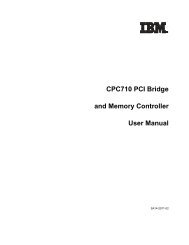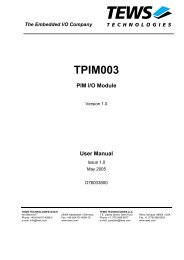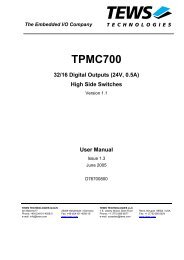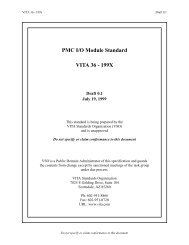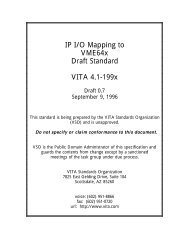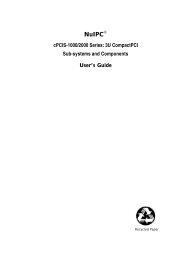MicroTCA TM - PICMG
MicroTCA TM - PICMG
MicroTCA TM - PICMG
Create successful ePaper yourself
Turn your PDF publications into a flip-book with our unique Google optimized e-Paper software.
Not Intended for Design - Do not Claim Compliance<br />
Interconnect<br />
The AdvancedMC Connector provides up to 21 ports of fabric interconnect connectivity. The MCH Connector<br />
provides up to 84 ports of fabric interconnect connectivity to up to twelve AdvancedMCs (normally seven fabrics<br />
for twelve AdvancedMCs). This gives the flexibility to support a variety of fabric topologies. The following sections<br />
describe two fabric topologies that are expected to cover many of the application requirements and can be supported<br />
with <strong>MicroTCA</strong> applications.<br />
Topology models<br />
There are fundamentally two <strong>MicroTCA</strong> topology models that can be adopted, these being the centralized MCH<br />
switch model and the Module-to-Module direct connectivity model. A mix of these topologies could exist within a<br />
given system. For example, a typical system could provide 1000BASE-BX Ethernet and/or PCI-Express as a<br />
centralized switched fabric. A storage topology could be routed as either direct Module-to-Module interconnects, or<br />
as a switched fabric.<br />
Centralized MCH switch model<br />
The general-purpose <strong>MicroTCA</strong> system could implement a centralized fabric-specific switch on the MCH. This<br />
allows point-to-point connectivity to be achieved from each Module to each and every other Module.<br />
Module-to-Module direct connectivity model<br />
It is allowed and supported to establish direct connection between a Port of one AdvancedMC Slot and a Port of<br />
another AdvancedMC Slot. This can help in developing optimized solutions.<br />
If the interconnect between two AdvancedMC Modules is based on LVDS, then it is required to make a cross-over<br />
on the Backplane between the transmit and receive pairs for each connected Port. This ensures that the transmit<br />
connections of one AdvancedMC are connected to the receive connections of the other AdvancedMC.<br />
JTAG interface<br />
Testing is an important issue in <strong>MicroTCA</strong> systems. The JTAG port supported in the AMC.0 specification provides<br />
a means to test the AdvancedMC Modules. <strong>MicroTCA</strong> extends this capability to test the entire <strong>MicroTCA</strong> system,<br />
including explicit definition for Power Modules and MCHs, and implicit allowance to extend testing capability to<br />
Cooling Units and OEM Modules which are outside the scope of the specification. This testing can occur at the<br />
subsystem level, at factory system test, and during field diagnostic operations. The system-wide test infrastructure is<br />
also valuable to update various non-volatile memories in a <strong>MicroTCA</strong> system, including those that hold<br />
microprocessor, DSP or NPU firmware, or FPGA configuration data.<br />
The JTAG support is provided via the Extended Side of the AdvancedMC Connector. The separate JTAG interfaces<br />
to the AdvancedMCs will allow the JTAG chain to be kept intact in the absence of an AdvancedMC in a Slot. The<br />
JTAG sub-system will provide independent access to each AdvancedMC Module, so Module-specific JTAG tests can<br />
be applied independently of the population configuration of the other Slots.<br />
The JTAG Star and Multi-drop architectures ideally provide this independent access, but are not directly possible for<br />
<strong>MicroTCA</strong>, given the existing pin-out and resources available in the AdvancedMC, as well as the physical size of the<br />
<strong>MicroTCA</strong> Carrier Hub (MCH) Connector.<br />
To support the user with a flexible interface, a JTAG Switch Module (JSM) is suggested to provide JTAG systemlevel<br />
support from the MCH Test Access Port (TAP) interface or an external tester interface. This interface provides a<br />
Star JTAG architecture, allowing the MCH or external tester to connect to each Module individually to perform test<br />
and update operations, while the MCH implements a single JTAG TAP interface at its edge. The MCH also is able to<br />
perform test and update operations on the redundant MCH.<br />
<strong>PICMG</strong>® MTCA.0 Short Form Specification, September 21 st , 2006 31 of 34




